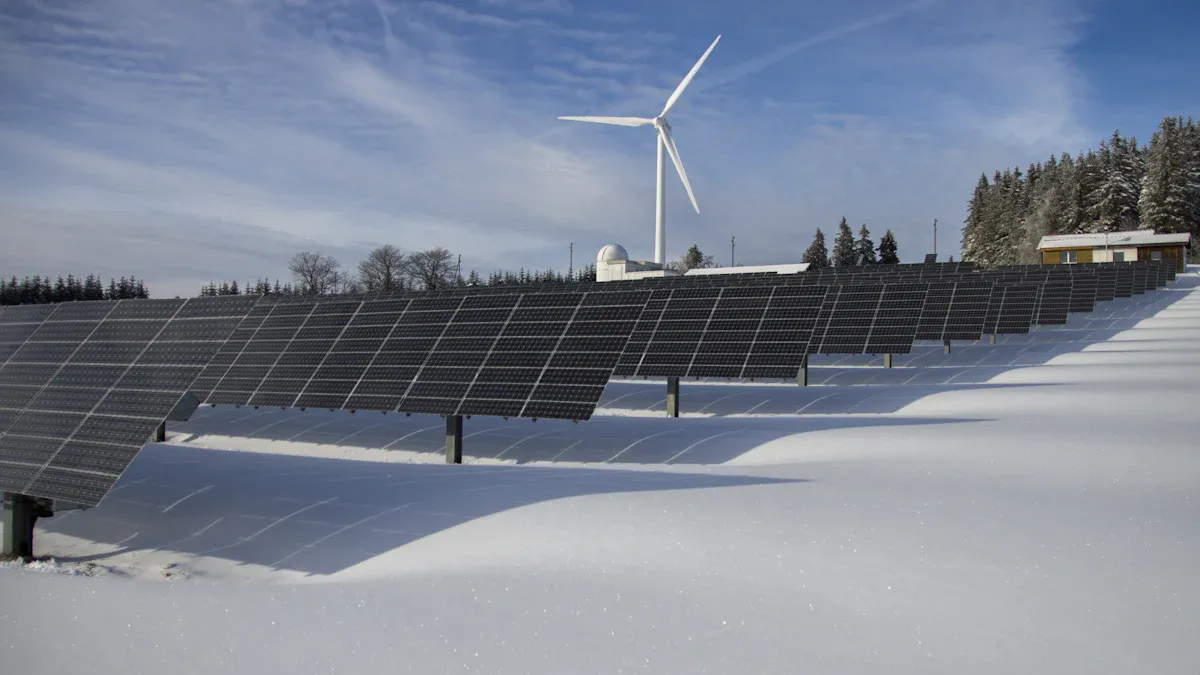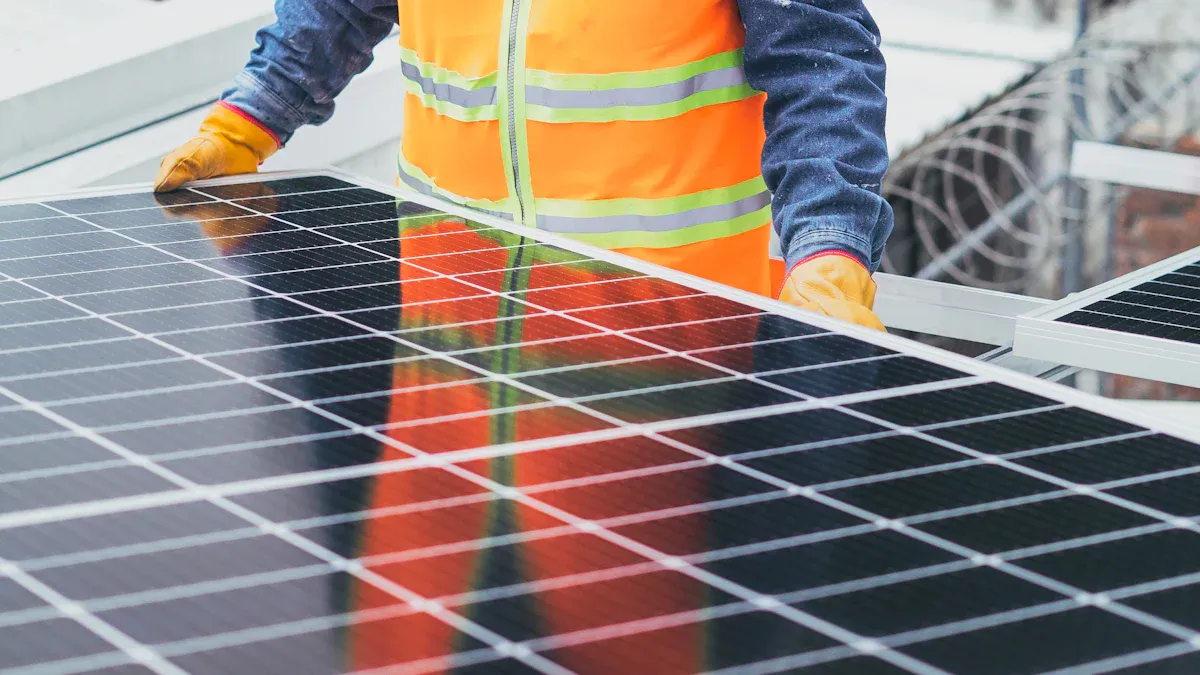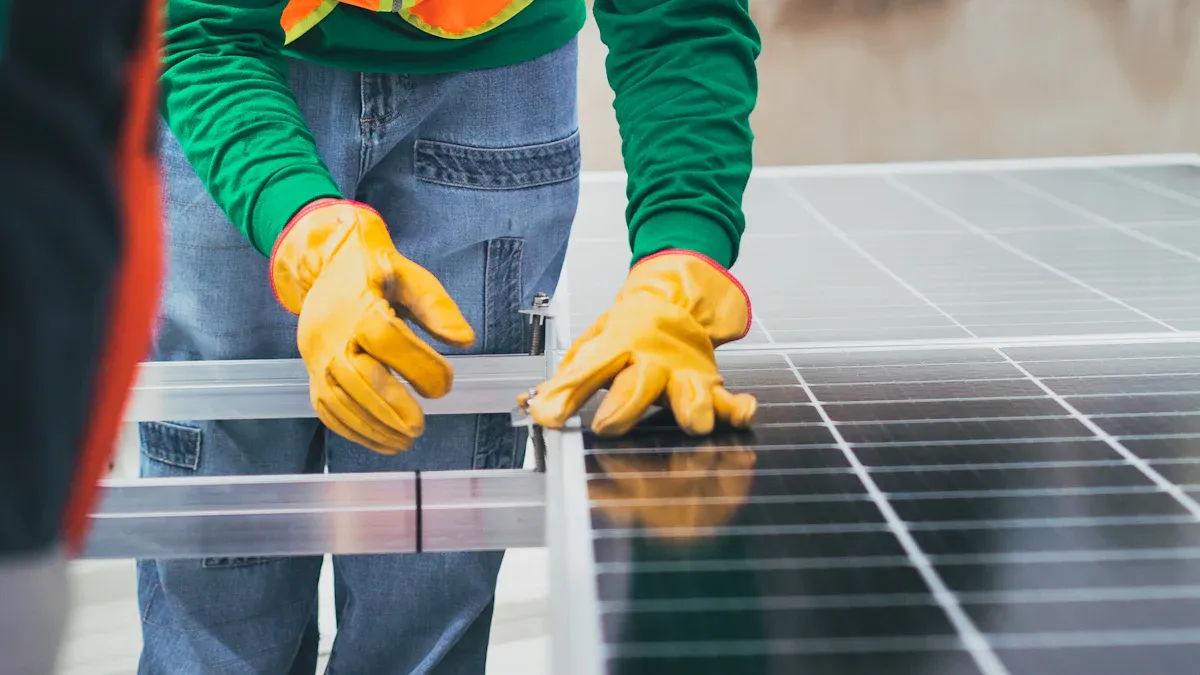ESTEL PV Panel Maintenance Checklist for Telecom Applications 2025

You rely on your telecom systems to deliver uninterrupted service. Regular maintenance of PV panels ensures that your operations stay efficient and dependable. When you perform routine maintenance, you gain several advantages:
You reduce telecom downtime by preventing unexpected failures.
Routine cleaning and inspections boost energy efficiency, keeping your telecom network running at peak performance.
Preventive maintenance promotes equipment longevity, saving you from costly repairs.
A well-chosen PV Panel for Telecom Cabinet supports optimal performance in demanding environments.
Adopting a proactive approach to maintenance helps you secure the reliability and efficiency your telecom infrastructure demands.
Key Takeaways
Regular cleaning and inspections keep your telecom PV panels efficient and prevent unexpected downtime.
Choose durable, weather-resistant PV panels designed for harsh telecom environments to ensure long-term performance.
Perform electrical tests and monitor system performance continuously to catch issues early and maintain safety.
Keep detailed maintenance records and schedule professional checkups to protect your investment and warranty.
Avoid common mistakes like skipping inspections, improper cleaning, and ignoring system warnings to maximize reliability.
Telecom PV Panel Needs

Environmental Factors
When you operate a solar-powered telecom site, you face unique environmental challenges. PV panel for telecom cabinet installations often sit in remote or harsh locations. Dust, debris, and salt spray can quickly build up on solar surfaces. These contaminants block sunlight, raise panel temperatures, and reduce efficiency. In desert or coastal regions, dust storms and humidity further threaten solar performance. Rain and high humidity can cause insulation failures, while UV radiation and temperature swings accelerate material aging. You must select corrosion-resistant materials and weatherproof designs to protect your solar telecom site from these threats.
Tip: Regular maintenance, including cleaning and inspection, helps you prevent dust buildup and corrosion, ensuring your PV panel for telecom cabinet delivers reliable solar energy.
Uptime and Reliability
Telecom networks demand high uptime. Service Level Agreements often require your solar-powered telecom systems to achieve at least 99.5% uptime. Any drop in solar efficiency can disrupt network operations and lead to costly downtime. You need to maintain your PV panel for telecom cabinet to avoid unexpected failures. Cleaning, monitoring, and timely repairs keep your solar system running smoothly. Proper maintenance ensures your telecom equipment receives stable power, even during extreme weather or heavy usage.
PV Panel for Telecom Cabinet
Choosing the right PV panel for telecom cabinet environments is essential. You need panels with outdoor durability, weather-tight enclosures, and corrosion resistance. Look for features like IP55-rated cabinets, hybrid power integration, and smart energy management. These panels support multiple voltage outputs, making them ideal for telecom applications. Thermal insulation and active cooling systems help maintain stable temperatures, boosting efficiency and extending equipment life. Lightweight aluminum alloy designs make installation and field deployment easier for your solar telecom site.
Note: Investing in a high-quality PV panel for telecom cabinet and following a strict maintenance schedule will maximize your solar energy output and ensure long-term performance for your telecom network.
Solar Panel Maintenance Checklist

Visual Inspection
You should perform a visual inspection of your solar panels and supporting structures at least twice a year. In regions with harsh weather, increase the frequency of inspections. During each inspection, look for corrosion, loose fasteners, and coating wear on steel structures. Examine the panels for cracks, discoloration, or any visible damage. Check for debris, bird droppings, or shading from nearby vegetation. After storms or extreme weather, conduct additional inspections to catch early signs of damage.
Tip: Keep a checklist for each visual inspection to ensure you do not miss any critical areas.
Cleaning
Regular cleaning is essential for optimal solar panel maintenance. Clean your panels at least once or twice a year, but increase the frequency to monthly or even weekly in dusty or polluted environments. Use lukewarm water, mild dish soap, and a soft sponge or cloth. Avoid abrasive materials and pressure washers, which can damage the panel surface. Clean panels during early morning or late evening to prevent thermal shock and streaking. Dry panels with a soft cloth after cleaning.
In remote or water-limited sites, consider waterless cleaning systems that use electrostatic repulsion to remove dust. These automated systems can prevent up to 30% energy loss caused by dust buildup and reduce operational costs. Trim nearby vegetation to minimize debris and shading. Always maintain a log of cleaning activities as part of your solar panel maintenance checklist.
Electrical Testing
Annual inspection and electrical testing are vital for safety and efficiency. Schedule insulation resistance tests, including wet leakage current tests, to ensure panels remain safe during rain or dew. Perform I-V curve tracing and power output tests to evaluate system performance. Use infrared thermographic inspections to detect hot spots or bypass diode failures. Test blocking diodes and inspect the inverter for proper operation. Record all test results for future reference.
Test Name | Purpose/Description | Measuring Instruments |
|---|---|---|
Open Circuit Voltage & String Current | Verify voltage and current output of PV strings | Multimeter |
Insulation Resistance Test | Prevent leakage currents and electrical hazards | Insulation Tester |
I-V Curve Test | Assess panel performance and efficiency | I-V Curve Tracer |
Infrared Thermographic Inspection | Detect abnormal heat generation and faults | Infrared Thermal Camera |
Blocking Diode Test | Ensure safe operation and prevent overheating | Digital Multimeter, Clamp Meter |
Wet Insulation Test | Validate insulation resistance under wet conditions | Insulation Tester |
Monitoring
You need to monitor system performance continuously to detect early signs of failure. Use sensors to track electrical parameters such as current and voltage, as well as environmental factors like temperature and solar radiation. Implement maximum power point tracking (MPPT) algorithms to optimize output. Advanced monitoring tools, including AI-enabled power conditioners and remote visualization software, help you identify degraded modules and issue warnings. Integrate condition monitoring systems that use infrared thermography and machine learning for early fault detection. These tools can identify hot spots, cracked cells, and bypass diode failures with high accuracy.
Note: Regular monitoring and software updates for inverters are essential for maintaining high system efficiency.
Structural Check
System inspections should include a thorough check of the mounting structures. Inspect for insufficient load capacity, corrosion, loose or damaged fastenings, and misalignment of panels. Ensure compliance with local building codes and standards. After severe weather, check for physical damage and structural instability. Professional installation and adherence to standards like those from the American Society of Civil Engineers (ASCE) help prevent failures.
Inspect structures at least twice a year.
Address any signs of corrosion or instability immediately.
Confirm that all fasteners remain secure and panels are properly aligned.
Cable and Connection Check
Inspect all cables and connections at least quarterly. Look for signs of wear, corrosion, or loose connections. Quarterly checks of battery health and connections are also necessary. Semi-annual testing of the inverter and charge controller ensures reliable operation. During each inspection, verify that all wiring is intact and properly secured. Replace damaged cables promptly to prevent system failures.
Alert: Poor cable connections can lead to significant performance loss and safety hazards.
Documentation
Maintain detailed records of all maintenance activities, including inspections, cleaning, electrical testing, and repairs. Use a maintenance log to track the condition of each panel and the frequency of cleaning. Document all findings during system inspections and note any corrective actions taken. This documentation supports warranty claims and helps you identify recurring issues.
Record dates and results of each inspection.
Log cleaning activities and methods used.
Keep test results and repair records organized for easy reference.
Professional Support
You should schedule an annual inspection and comprehensive checkup with solar panel maintenance services. Professionals will inspect voltage strings, hardware condition, and lid seals. Seek expert help for malfunctioning systems, leaks, wiring defects, or hardware failures. Critical repairs, including damage to panels or system components, require technicians with technical expertise. While you can handle routine cleaning and monitoring, rely on solar panel maintenance services when system performance drops or complex repairs are needed.
Tip: Proactive engagement with professional support ensures long-term reliability and maximizes your solar investment.
Solar Operations and Maintenance
Preventative Schedule
You need a robust preventative maintenance schedule to keep your telecom solar systems running at peak performance. Regular site walks and scheduled checks help you catch issues before they cause downtime. A strong solar operations and maintenance plan includes:
Battery backup testing to confirm power availability during outages.
Power protection with surge protectors and UPS systems.
Routine HVAC maintenance for proper cooling and humidity control.
Physical inspections of wiring, connectors, and mounting hardware.
Scheduled software and firmware upgrades.
Network security assessments to guard against unauthorized access.
Vendor management for timely repairs and quality assurance.
Use of remote monitoring tools for real-time status updates.
Proper cable management to prevent damage and improve airflow.
Implementation of backup systems like generators and alternative network routes.
Use of CMMS software to manage maintenance tasks efficiently.
You should adjust the frequency of maintenance based on environmental factors such as dust, temperature, and humidity. Early detection and replacement of suspicious components prevent costly failures. Preventive maintenance ensures your solar operations and maintenance program delivers reliable power to your telecom network.
Monitoring Tools
You can maximize solar operations and maintenance efficiency by using advanced monitoring tools. Monitoring apps give you instant access to real-time system data and send alerts when they detect issues. These tools help you monitor system performance, optimize energy output, and reduce maintenance costs. DC energy meters provide accurate measurements of direct current output, supporting performance tracking and ROI calculations. Remote monitoring tools like Remote Telemetry Units (RTUs) deliver continuous data on environmental conditions, power output, and battery status. You can integrate these systems with existing energy management platforms, making adoption seamless. Continuous data collection helps you identify trends and address gradual equipment degradation before it leads to critical failures.
Tip: Real-time monitoring and regular software updates keep your solar operations and maintenance program proactive and efficient.
Staff Training
You must invest in staff training to ensure effective solar operations and maintenance. Well-trained personnel can perform routine maintenance, recognize early warning signs, and respond quickly to issues. Training should cover cleaning procedures, inspection techniques, and the use of remote monitoring tools. Staff should also learn how to interpret performance data and carry out preventive maintenance tasks. Ongoing education keeps your team updated on the latest solar panel maintenance practices and technology advancements. When your staff understands the full scope of solar operations and maintenance, you reduce downtime and extend the life of your telecom PV systems.
Common Mistakes in Maintenance
Skipping Inspections
You might feel tempted to skip regular inspections, especially when your system appears to operate smoothly. However, missing scheduled checks can allow hidden defects and damage to go unnoticed. These issues, such as internal circuit faults or microcracks, often require advanced techniques like Electroluminescence imaging to detect. If you neglect inspections, you risk reduced power generation, unexpected outages, and higher long-term maintenance costs. Routine inspections help you catch problems early and maintain reliable telecom operations.
Tip: Schedule both visual and advanced inspections at set intervals. Use trained personnel and the right diagnostic tools to ensure thorough quality control.
Improper Cleaning
Cleaning your panels incorrectly can cause more harm than good. Using abrasive tools or harsh chemicals may scratch the surface and reduce efficiency. Cleaning panels during the hottest part of the day or with cold water can cause thermal stress, leading to cracks. Attempting to clean live panels or using conductive equipment increases the risk of electric shock and fire hazards. You should always use soft brushes, purified water, and non-conductive tools. Automated cleaning systems can help reduce human error and improve safety, especially in remote telecom sites.
Avoid cleaning panels when they are hot.
Never use abrasive materials or harsh chemicals.
Isolate panels before cleaning to minimize electrical hazards.
Ignoring Warnings
Ignoring error lights, warning messages, or abnormal performance data can lead to serious failures. Many telecom PV systems rely on monitoring tools to alert you to issues like inverter faults, ground faults, or communication errors. If you overlook these warnings, you may miss early signs of system degradation or safety risks. Rodents, birds, or severe weather can also cause hidden damage that triggers alerts. Always investigate and address warnings promptly to prevent downtime and costly repairs.
Alert: Respond quickly to all system alerts and error messages. Regularly review monitoring data to spot trends and address issues before they escalate.
Common mistakes you should avoid include:
Neglecting cleaning and maintenance schedules, which allows dust and debris to reduce efficiency.
Forgetting electrical maintenance, leading to loose connections and safety hazards.
Attempting DIY repairs without proper expertise, risking improper care.
Overlooking pest control, which can result in animal damage and shading.
Ignoring warranty terms, potentially voiding coverage.
By staying proactive and following best practices, you maximize system performance and extend the life of your telecom PV installation.
By following the ESTEL PV panel maintenance checklist, you ensure your telecom systems operate at peak efficiency and reliability. Regular maintenance helps you detect issues early, keep panels clean, and optimize energy output. This approach extends the lifespan of your equipment and prevents costly repairs. For advanced support, consult ESTEL experts who can provide professional inspections and guidance. Adopting a proactive maintenance strategy safeguards your investment and keeps your telecom network running smoothly.
FAQ
How often should you clean your telecom PV panels?
You should clean your PV panels at least twice a year. In dusty or polluted areas, increase cleaning frequency to monthly. Regular cleaning prevents dust buildup and keeps your system efficient.
What tools do you need for safe PV panel cleaning?
Use a soft sponge, mild dish soap, and lukewarm water. Avoid abrasive materials and pressure washers. For remote sites, consider waterless cleaning systems. Always wear insulated gloves for safety.
Can you perform electrical tests without professional help?
You can check basic connections and look for visible issues. For insulation resistance tests or I-V curve tracing, contact a qualified technician. Professional testing ensures safety and accurate results.
What should you do if you see an error light on your system?
Alert:
Investigate the warning immediately. Check your monitoring system for details. If you cannot resolve the issue, contact ESTEL support for expert assistance.
Does regular maintenance affect your PV panel warranty?
Yes, regular maintenance helps you keep your warranty valid. Always document inspections, cleaning, and repairs. Follow manufacturer guidelines to avoid voiding your coverage.
See Also
Essential Advice For Caring For ESTEL Outdoor Telecom Cabinets
Solar Energy Storage Solutions Designed For Telecom Cabinets
ESTEL’s Comprehensive Guide To Telecom Cabinet Equipment Standards
Simplified Steps For Installing ESTEL Outdoor Telecom Cabinets
Choosing And Installing Pole-Mounted Telecom Cabinets Safely And Effectively
CALL US DIRECTLY
86-13752765943
3A-8, SHUIWAN 1979 SQUARE (PHASE II), NO.111, TAIZI ROAD,SHUIWAN COMMUNITY, ZHAOSHANG STREET, NANSHAN DISTRICT, SHENZHEN, GUANGDONG, CHINA


